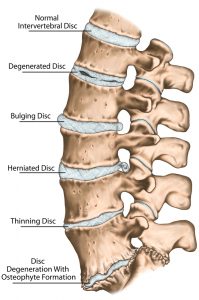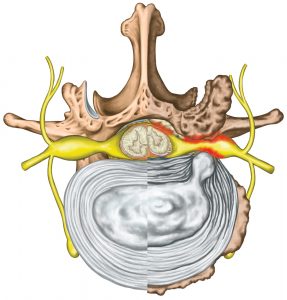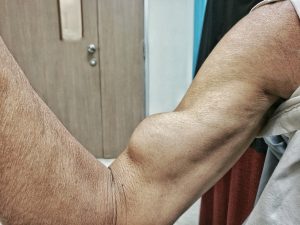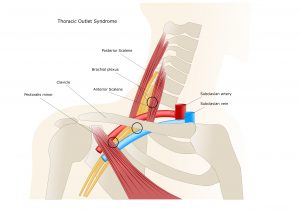Referred Pain into the Elbow
Referred pain in the elbow can come from trapped nerves in the neck, or from shoulder problems (biceps tendon tear or thoracic outlet syndrome).
Referred pain from the neck – Trapped nerves in the neck
Typical symptoms: Pain will be felt in other areas of the body such as shoulder, arm, elbow and hands. These can be perceived as a constant dull ache often combined with pins and needles.
Herniated and Bulging Discs in the Neck
There are a few terms commonly used when describing discs which we can quickly clarify.
A disc bulge is where the outer wall of the disc bulges out from its normal position. The disc wall is not broken, and the nucleus material is contained inside the disc. As the disc bulges, it may press against nerves directly or the bulge is associated with a loss of disc height and this may lead to impingement of a nerve as it exits the spinal canal though the gap between two vertebrae.
A herniated disc is the same as a prolapsed disc. This is where the nucleus of the disc breaks through the outer disc wall. There will be a loss of disc height as the disc loses pressure and the nucleus material can press directly on to the spinal nerves causing pain. Or the material of the disc nucleus may act as a biochemical irritation to the nerve, in which case the result is the same… pain!
A ‘slipped disc’ is an everyday expression which doesn’t have a true medical definition. It can imply a disc bulge or a herniation, usually a herniation.
The MRI below demonstrates a herniated disc pressing on nerves in the neck before and after treatment with IDD Therapy that we offer at our Buxton clinic.
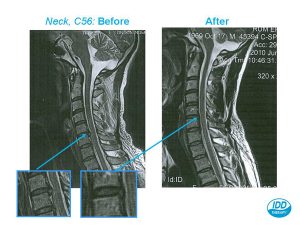
The resulting pain from a herniated disc will often refer (hence the term radicular pain) down the pathway of a nerve and into the limb it innervates causing either sciatica (in the case of the lower back) or pain into the neck, shoulder and arm (if in the neck). This can often be accompanied with pins and needles in the foot or hand depending on this location.
Our IDD Therapy programme can help treat trapped nerves, is non-invasive (unlike surgery) and is pain-free. IDD Therapy bridges the gap between what manual therapy cannot achieve and surgery. This therapy is the fastest growing therapy for trapped nerves and degenerative disc issues in the UK.
Referred pain from the shoulder – Biceps tendinopathy and tendon rupture
Typical symptoms: Pain at the front of the shoulder and an aching down the upper arm to the elbow.
There are various shoulder conditions that can potentially refer pain down the arm towards the elbow (such as shoulder instability or osteoarthritis or rotator cuff tendinopathy) but to keep things simple I have outlined just two that will create pain specifically at or below the elbow. A rupture of the biceps tendon is the first (the biceps tendon inserts just below the elbow), and the second is Thoracic Outlet Syndrome, which will refer pain or loss of sensation to the whole limb.
The biceps muscle lies in the front of your upper arm as most of us know. It helps you bend your elbow and rotate your arm. It also helps keep your shoulder stable. The biceps muscle has two tendons that attach it to bones in the shoulder and, at the other end, bones in the elbow.
Occupations that involve overhead shoulder work or heavy lifting are at risk are often at risk of biceps problems. Biceps tendons can tear and rupture in which case the muscle retracts as seen in the picture below. These tears can be partial or complete. Complete tears require surgical repair.
Symptoms include the following:
- Swelling in the front of the elbow
- Visible bruising in the elbow and forearm
- Weakness in bending of the elbow
- Weakness in twisting the forearm (supination)
- A bulge in the upper part of the arm created by the recoiled, shortened biceps muscle
- A gap in the front of the elbow created by the absence of the tendon.
Referred pain from the shoulder – Thoracic outlet syndrome
Thoracic outlet syndrome (TOS) is when blood vessels or nerves in the space between your collarbone and your first rib (this is called the thoracic outlet) become squashed. This anatomical space can be seen in the diagram below.
TOS can cause pain in your shoulders, arm and neck and numbness in your fingers. This can happen for a variety of difference reasons such as a traumatic onset (from a road traffic accident) or it can be sports related, occupational or even variations in your anatomy (some people have an extra rib). The good news is that in most cases this condition usually responds well to manual therapy.
TOS affects approximately 8% of the population and is 3-4 times as frequent in woman as in men between the age of 20 and 50 years. Females have less-developed muscles, a greater tendency for drooping shoulders owing to additional chest tissue. They also have a narrow thoracic outlet and an anatomical lower sternum which all contrives to make them more susceptible.
The mean age of people effected with TOS is 30s-40s; it is rarely seen in children. Almost all cases of TOS (95-98%) affect the nerves from the neck (or brachial plexus); the other 2-5% affecting vascular structures, such as the subclavian artery and vein.
Obviously the symptoms of TOS differ quite significantly between each person because this depends which nerves or major blood vessels are being pressed on and how much. Generally people present with pain anywhere between the neck, face and back of their neck or into the chest, shoulder and upper arm and this can also be allied with pins and needles. People can also complain of altered or absent sensation, weakness, fatigue, a feeling of heaviness in the arm and hand. The skin can also be blotchy and cold.
The main reasons for TOS are often because of tight muscles in the neck (called scalenes) or chest (pectoralis minor), or the position of collar bone (clavicle) or first rib.
